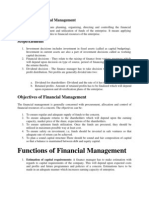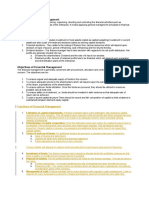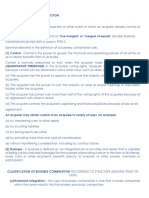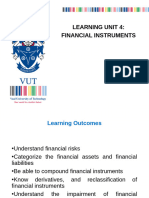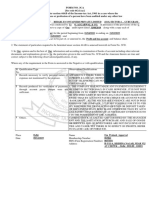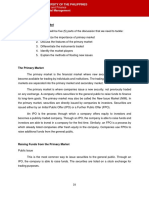0 ratings0% found this document useful (0 votes)
72 viewsFinancial Management
Financial Management
Uploaded by
Mik MikThis document discusses various topics related to financial management including:
1. The meaning of financial management and its objectives such as ensuring adequate funds and optimal utilization of funds.
2. The scope and elements of financial management including investment decisions, financial decisions, and dividend decisions.
3. The functions of a financial manager including estimating capital requirements, determining capital structure, choosing sources of funds, and managing cash.
4. The definition and objectives of financial planning such as determining capital needs and framing financial policies.
Copyright:
© All Rights Reserved
Available Formats
Download as DOC, PDF, TXT or read online from Scribd
Financial Management
Financial Management
Uploaded by
Mik Mik0 ratings0% found this document useful (0 votes)
72 views6 pagesThis document discusses various topics related to financial management including:
1. The meaning of financial management and its objectives such as ensuring adequate funds and optimal utilization of funds.
2. The scope and elements of financial management including investment decisions, financial decisions, and dividend decisions.
3. The functions of a financial manager including estimating capital requirements, determining capital structure, choosing sources of funds, and managing cash.
4. The definition and objectives of financial planning such as determining capital needs and framing financial policies.
Copyright
© © All Rights Reserved
Available Formats
DOC, PDF, TXT or read online from Scribd
Share this document
Did you find this document useful?
Is this content inappropriate?
This document discusses various topics related to financial management including:
1. The meaning of financial management and its objectives such as ensuring adequate funds and optimal utilization of funds.
2. The scope and elements of financial management including investment decisions, financial decisions, and dividend decisions.
3. The functions of a financial manager including estimating capital requirements, determining capital structure, choosing sources of funds, and managing cash.
4. The definition and objectives of financial planning such as determining capital needs and framing financial policies.
Copyright:
© All Rights Reserved
Available Formats
Download as DOC, PDF, TXT or read online from Scribd
Download as doc, pdf, or txt
0 ratings0% found this document useful (0 votes)
72 views6 pagesFinancial Management
Financial Management
Uploaded by
Mik MikThis document discusses various topics related to financial management including:
1. The meaning of financial management and its objectives such as ensuring adequate funds and optimal utilization of funds.
2. The scope and elements of financial management including investment decisions, financial decisions, and dividend decisions.
3. The functions of a financial manager including estimating capital requirements, determining capital structure, choosing sources of funds, and managing cash.
4. The definition and objectives of financial planning such as determining capital needs and framing financial policies.
Copyright:
© All Rights Reserved
Available Formats
Download as DOC, PDF, TXT or read online from Scribd
Download as doc, pdf, or txt
You are on page 1of 6
FINANCIAL MANAGEMENT
TIME/ROOM-10:00-1:00/M301
Meaning of Financial Management
Financial Management means planning, organizing, directing and
controlling the financial activities such as procurement and utilization of
funds of the enterprise. It means applying general management
principles to financial resources of the enterprise.
Scope/Elements
1. Investment decisions includes investment in fixed assets (called as
capital budgeting). Investments in current assets are also a part of
investment decisions called as working capital decisions.
2. Financial decisions - They relate to the raising of finance from
various resources which will depend upon decision on type of
source, period of financing, cost of financing and the returns
thereby.
Dividend decision - The finance manager has to take decision with
regards to the net profit distribution. Net profits are generally divided
into two:
a. Dividend for shareholders- Dividend and the rate of it has to
be decided.
b. Retained profits- Amount of retained profits has to be
finalized which will depend upon expansion and
diversification plans of the enterprise.
Objectives of Financial Management
The financial management is generally concerned with procurement,
allocation and control of financial resources of a concern. The objectives
can be-
1. To ensure regular and adequate supply of funds to the concern.
2. To ensure adequate returns to the shareholders which will depend
upon the earning capacity, market price of the share, expectations
of the shareholders.
3. To ensure optimum funds utilization. Once the funds are procured,
they should be utilized in maximum possible way at least cost.
4. To ensure safety on investment, i.e., funds should be invested in
safe ventures so that adequate rate of return can be achieved.
5. To plan a sound capital structure-There should be sound and fair
composition of capital so that a balance is maintained between
debt and equity capital.
Functions of Financial Management
1. Estimation of capital requirements: A finance manager has to
make estimation with regards to capital requirements of the
company. This will depend upon expected costs and profits and
future programmes and policies of a concern. Estimations have to
be made in an adequate manner which increases earning capacity
of enterprise.
2. Determination of capital composition: Once the estimation have
been made, the capital structure have to be decided. This involves
short- term and long- term debt equity analysis. This will depend
upon the proportion of equity capital a company is possessing and
additional funds which have to be raised from outside parties.
3. Choice of sources of funds: For additional funds to be procured,
a company has many choices like-
a. Issue of shares and debentures
b. Loans to be taken from banks and financial institutions
c. Public deposits to be drawn like in form of bonds.
Choice of factor will depend on relative merits and demerits of each
source and period of financing.
4. Investment of funds: The finance manager has to decide to
allocate funds into profitable ventures so that there is safety on
investment and regular returns is possible.
5. Disposal of surplus: The net profits decisions have to be made by
the finance manager. This can be done in two ways:
a. Dividend declaration - It includes identifying the rate of
dividends and other benefits like bonus.
b. Retained profits - The volume has to be decided which will
depend upon expansional, innovational, diversification plans
of the company.
6. Management of cash: Finance manager has to make decisions
with regards to cash management. Cash is required for many
purposes like payment of wages and salaries, payment of electricity
and water bills, payment to creditors, meeting current liabilities,
maintenance of enough stock, purchase of raw materials, etc.
Financial controls: The finance manager has not only to plan, procure
and utilize the funds but he also has to exercise control over finances.
This can be done through many techniques like ratio analysis, financial
forecasting, cost and profit control, etc.
Definition of Financial Planning
Financial Planning is the process of estimating the capital required and
determining it’s competition. It is the process of framing financial policies
in relation to procurement, investment and administration of funds of an
enterprise.
Objectives of Financial Planning
Financial Planning has got many objectives to look forward to:
a. Determining capital requirements- This will depend upon factors
like cost of current and fixed assets, promotional expenses and
long- range planning. Capital requirements have to be looked with
both aspects: short- term and long- term requirements.
b. Determining capital structure- The capital structure is the
composition of capital, i.e., the relative kind and proportion of
capital required in the business. This includes decisions of debt-
equity ratio- both short-term and long- term.
c. Framing financial policies with regards to cash control, lending,
borrowings, etc.
A finance manager ensures that the scarce financial resources are
maximally utilized in the best possible manner at least cost in order to
get maximum returns on investment.
Importance of Financial Planning
Financial Planning is process of framing objectives, policies, procedures,
programmes and budgets regarding the financial activities of a concern.
This ensures effective and adequate financial and investment policies.
The importance can be outlined as-
1. Adequate funds have to be ensured.
2. Financial Planning helps in ensuring a reasonable balance between
outflow and inflow of funds so that stability is maintained.
3. Financial Planning ensures that the suppliers of funds are easily
investing in companies which exercise financial planning.
4. Financial Planning helps in making growth and expansion
programmes which helps in long-run survival of the company.
5. Financial Planning reduces uncertainties with regards to changing
market trends which can be faced easily through enough funds.
6. Financial Planning helps in reducing the uncertainties which can
be a hindrance to growth of the company. This helps in ensuring
stability and profitability in concern.
Finance Functions
The following explanation will help in understanding each finance function in
detail
Investment Decision
One of the most important finance functions is to intelligently allocate
capital to long term assets. This activity is also known as capital
budgeting. It is important to allocate capital in those long term assets so
as to get maximum yield in future. Following are the two aspects of
investment decision
a. Evaluation of new investment in terms of profitability
b. Comparison of cut off rate against new investment and prevailing
investment.
Since the future is uncertain therefore there are difficulties in calculation
of expected return. Along with uncertainty comes the risk factor which
has to be taken into consideration. This risk factor plays a very
significant role in calculating the expected return of the prospective
investment. Therefore while considering investment proposal it is
important to take into consideration both expected return and the risk
involved.
Investment decision not only involves allocating capital to long term
assets but also involves decisions of using funds which are obtained by
selling those assets which become less profitable and less productive. It
wise decisions to decompose depreciated assets which are not adding
value and utilize those funds in securing other beneficial assets. An
opportunity cost of capital needs to be calculating while dissolving such
assets. The correct cut off rate is calculated by using this opportunity
cost of the required rate of return (RRR)
Financial Decision
Financial decision is yet another important function which a financial
manger must perform. It is important to make wise decisions about
when, where and how should a business acquire funds. Funds can be
acquired through many ways and channels. Broadly speaking a correct
ratio of an equity and debt has to be maintained. This mix of equity
capital and debt is known as a firm’s capital structure. A firm tends to
benefit most when the market value of a company’s share maximizes this
not only is a sign of growth for the firm but also maximizes shareholders
wealth. On the other hand the use of debt affects the risk and return of a
shareholder. It is more risky though it may increase the return on equity
funds. A sound financial structure is said to be one which aims at
maximizing shareholders return with minimum risk. In such a scenario
the market value of the firm will maximize and hence an optimum capital
structure would be achieved. Other than equity and debt there are
several other tools which are used in deciding a firm capital structure.
Dividend Decision
Earning profit or a positive return is a common aim of all the businesses.
But the key function a financial manger performs in case of profitability
is to decide whether to distribute all the profits to the shareholder or
retain all the profits or distribute part of the profits to the shareholder
and retain the other half in the business. It’s the financial manager’s
responsibility to decide an optimum dividend policy which maximizes the
market value of the firm. Hence an optimum dividend payout ratio is
calculated. It is a common practice to pay regular dividends in case of
profitability another way is to issue bonus shares to existing
shareholders.
Liquidity Decision
It is very important to maintain a liquidity position of a firm to avoid
insolvency. Firm’s profitability, liquidity and risk all are associated with
the investment in current assets. In order to maintain a tradeoff between
profitability and liquidity it is important to invest sufficient funds in
current assets. But since current assets do not earn anything for
business therefore a proper calculation must be done before investing in
current assets. Current assets should properly be valued and disposed of
from time to time once they become non profitable. Currents assets must
be used in times of liquidity problems and times of insolvency.
You might also like
- Elements of Corporate FinanceDocument9 pagesElements of Corporate FinanceReiki Channel Anuj Bhargava100% (1)
- Financial Management - Meaning, Objectives and FunctionsDocument29 pagesFinancial Management - Meaning, Objectives and FunctionsNardsdel RiveraNo ratings yet
- Financial Management NotesDocument30 pagesFinancial Management NotesChaitanya DongareNo ratings yet
- Financial Management - Meaning, Objectives and FunctionsDocument13 pagesFinancial Management - Meaning, Objectives and FunctionsJose Conrad Nupia BagonNo ratings yet
- Meaning of Financial ManagementDocument6 pagesMeaning of Financial ManagementYummyNo ratings yet
- Meaning of Financial ManagementassDocument13 pagesMeaning of Financial ManagementassMayankNo ratings yet
- Financial Management - Meaning, Objectives and Functions Meaning of Financial ManagementDocument6 pagesFinancial Management - Meaning, Objectives and Functions Meaning of Financial ManagementsupriyaswainNo ratings yet
- Finance ManagementDocument39 pagesFinance ManagementDevesh KankariyaNo ratings yet
- Entreprenurship & Management-Module 4 - WatermarkDocument11 pagesEntreprenurship & Management-Module 4 - Watermark81 SYBCOM A SHREYA SHINDENo ratings yet
- Modules in Financial ManagementDocument12 pagesModules in Financial ManagementMichael Linard Samiley100% (1)
- Financial Management - Meaning, Objectives and Functions Meaning of Financial ManagementDocument9 pagesFinancial Management - Meaning, Objectives and Functions Meaning of Financial ManagementGely MhayNo ratings yet
- Introduction To Financial ManagementDocument13 pagesIntroduction To Financial ManagementKayes Mohammad Bin HossainNo ratings yet
- The Scope and Environment of Financial ManagementDocument3 pagesThe Scope and Environment of Financial Managementgian reyesNo ratings yet
- Functions of Financial ManagementDocument5 pagesFunctions of Financial ManagementAthar KhanNo ratings yet
- Financial Management Meaning of Financial ManagementDocument17 pagesFinancial Management Meaning of Financial ManagementNoriel Justine QueridoNo ratings yet
- Financial ManagementDocument14 pagesFinancial ManagementMru SurveNo ratings yet
- Meaning of Financial ManagementDocument8 pagesMeaning of Financial ManagementDinesh GNo ratings yet
- Financial ManagementDocument2 pagesFinancial ManagementJanelle GalvezNo ratings yet
- Module 1 FinmanDocument7 pagesModule 1 FinmanJane GalangueNo ratings yet
- Financial Management NotesDocument10 pagesFinancial Management NotesMubarak Basha100% (1)
- Meaning of Financial ManagementDocument5 pagesMeaning of Financial ManagementJiya FaarNo ratings yet
- Meaning of Financial ManagementDocument4 pagesMeaning of Financial ManagementchantieeeNo ratings yet
- Financial Management - Meaning, Objectives and FunctionsDocument5 pagesFinancial Management - Meaning, Objectives and FunctionsDarshan AradhyaNo ratings yet
- Mcom 101Document12 pagesMcom 101Vishal KatheriyaNo ratings yet
- Meaning of Financial Management: Scope/ElementsDocument9 pagesMeaning of Financial Management: Scope/ElementsLovida AspilaNo ratings yet
- Topic 1 Introduction To Financial ManagementDocument9 pagesTopic 1 Introduction To Financial ManagementkiokocurtisNo ratings yet
- Reading Materials in Lesson 1 FM 2023Document17 pagesReading Materials in Lesson 1 FM 2023Czamille Rivera GonzagaNo ratings yet
- Financial Management and ControlDocument31 pagesFinancial Management and Controljeof basalof100% (1)
- Meaning of Financial ManagementDocument3 pagesMeaning of Financial ManagementvanisagiNo ratings yet
- Meaning, Scope, Objective, Function of Financial ManagementDocument3 pagesMeaning, Scope, Objective, Function of Financial ManagementAnand VermaNo ratings yet
- Unit - 2 (Hotel Accounts)Document5 pagesUnit - 2 (Hotel Accounts)Joseph Kiran ReddyNo ratings yet
- Maria Leizel San Buenaventure Bsa Iii-2: Scope/ElementsDocument3 pagesMaria Leizel San Buenaventure Bsa Iii-2: Scope/ElementsJoo GabrielNo ratings yet
- Financial Management - Lecture 1Document13 pagesFinancial Management - Lecture 1Kisekka BarnabasiNo ratings yet
- Financial Management - Meaning, Objectives and Functions Meaning of Financial ManagementDocument3 pagesFinancial Management - Meaning, Objectives and Functions Meaning of Financial ManagementGirraj Prasad MinaNo ratings yet
- Meaning of Financial ManagementDocument4 pagesMeaning of Financial ManagementSheila Mae AramanNo ratings yet
- Definition of Financial ManagementDocument4 pagesDefinition of Financial Managementsarvesh.bhartiNo ratings yet
- Inventory ManagementDocument109 pagesInventory ManagementsreevardhanNo ratings yet
- Financial Management AssignmentDocument5 pagesFinancial Management AssignmentZeeshan UmerNo ratings yet
- Unit 4Document7 pagesUnit 4Harsh YadavNo ratings yet
- Financial ManagementggsDocument10 pagesFinancial ManagementggsJessica Nicole DuqueNo ratings yet
- Research: Introduction To Financial ManagementDocument2 pagesResearch: Introduction To Financial ManagementklifeNo ratings yet
- Financial Management - Meaning, Objectives and FunctionsDocument5 pagesFinancial Management - Meaning, Objectives and FunctionsRuchi ChhabraNo ratings yet
- Presentation 2Document10 pagesPresentation 2Gopal DasNo ratings yet
- Financial Management: ElementsDocument4 pagesFinancial Management: Elementsharshit mahajanNo ratings yet
- Fin 109Document3 pagesFin 109Jenina Rose SalvadorNo ratings yet
- Meaning, Scope & Objectives of Financial ManagementDocument3 pagesMeaning, Scope & Objectives of Financial ManagementAmanDeep SinghNo ratings yet
- Financial ManagementDocument47 pagesFinancial ManagementruhimeggiNo ratings yet
- DMBA 202 - Financial Management..Document8 pagesDMBA 202 - Financial Management..shikhatiwaryNo ratings yet
- Finman ReviewerDocument27 pagesFinman Reviewerben yiNo ratings yet
- Financial ManagementDocument9 pagesFinancial ManagementGogineni sai spandanaNo ratings yet
- Assignment # 1: Submitted FromDocument16 pagesAssignment # 1: Submitted FromAbdullah AliNo ratings yet
- Financial Management Module-1 Meaning of Financial ManagementDocument14 pagesFinancial Management Module-1 Meaning of Financial ManagementBasavaraj AsaraddiNo ratings yet
- UntitledDocument3 pagesUntitledZeyNo ratings yet
- First HomeworkDocument6 pagesFirst HomeworkDanaNo ratings yet
- Introduction To Financial ManagementDocument24 pagesIntroduction To Financial ManagementKabile MwitaNo ratings yet
- Financial ManagementDocument33 pagesFinancial ManagementAkash k.cNo ratings yet
- Topic 8Document26 pagesTopic 8Christine SantosNo ratings yet
- How Beginners Achieve Financial Success: A Guide to Understanding Risk and ReturnFrom EverandHow Beginners Achieve Financial Success: A Guide to Understanding Risk and ReturnNo ratings yet
- Meghna Life Insurance Financial Performance AnalysisDocument16 pagesMeghna Life Insurance Financial Performance AnalysisshagorprNo ratings yet
- Chapter 2 - Cost of CapitalDocument10 pagesChapter 2 - Cost of CapitalHastings KapalaNo ratings yet
- FMR September 2023Document35 pagesFMR September 2023Zunaira SafdarNo ratings yet
- 24 Top Financial FormulasDocument1 page24 Top Financial FormulasNgọc Linh NguyễnNo ratings yet
- Investor Presentation September 2023Document59 pagesInvestor Presentation September 2023Thị Yến Nhi HồNo ratings yet
- Form AOC-4-19012024 - SignedDocument14 pagesForm AOC-4-19012024 - SignedAditya SinghNo ratings yet
- Financial Statement Analysis of Jollibee Food Corporation and Max's Group IncDocument17 pagesFinancial Statement Analysis of Jollibee Food Corporation and Max's Group IncRem100% (2)
- FINMAN ReqDocument1 pageFINMAN ReqVal PinedaNo ratings yet
- Lecture NotesDocument7 pagesLecture Noteskaren perrerasNo ratings yet
- Board of Studies Academic Capital Structure Questions 1649402823Document6 pagesBoard of Studies Academic Capital Structure Questions 1649402823Arundhathi MNo ratings yet
- Updated Complete Cash Flow StatementDocument46 pagesUpdated Complete Cash Flow StatementYashasvi DhankharNo ratings yet
- FREP01-OS Consolidation P2 - TWCC LTD SolutionDocument6 pagesFREP01-OS Consolidation P2 - TWCC LTD SolutionZintle KeswaNo ratings yet
- Capital Structure Theories VivaDocument43 pagesCapital Structure Theories VivaPuttu Guru PrasadNo ratings yet
- LU4 - Financial Instruments Slides LessonDocument18 pagesLU4 - Financial Instruments Slides LessonVuqueia RamosNo ratings yet
- CFAS Semestral ProjectDocument21 pagesCFAS Semestral ProjectCASSANDRANo ratings yet
- Top 7 IFRSMistakesDocument23 pagesTop 7 IFRSMistakesBobby ALONo ratings yet
- HBA Course Outline Sept - Dec 2023 - BUS4574Document11 pagesHBA Course Outline Sept - Dec 2023 - BUS4574SimplyNo ratings yet
- Capital Structure - SumsDocument3 pagesCapital Structure - Sumsmeet daftaryNo ratings yet
- Question On Financial Instruments - Part 1Document9 pagesQuestion On Financial Instruments - Part 1pratikdubey9586No ratings yet
- Post Date Value Date Narration Cheque Details Debit Credit BalanceDocument3 pagesPost Date Value Date Narration Cheque Details Debit Credit Balanceeadul365No ratings yet
- 6 CHP 13 14 15 SolutionDocument21 pages6 CHP 13 14 15 SolutionBijay AgrawalNo ratings yet
- C213 Study Guide - SolutionDocument23 pagesC213 Study Guide - Solutiondesouzas.ldsNo ratings yet
- Computation of Income: Nazneen Mohammed Javed ShaikhDocument3 pagesComputation of Income: Nazneen Mohammed Javed ShaikhRahul RampalNo ratings yet
- 2020 08 08 16 32 44 678 - Aaecb8489p - 2019Document16 pages2020 08 08 16 32 44 678 - Aaecb8489p - 2019Jyoti MeenaNo ratings yet
- Lecture 1Document79 pagesLecture 1Aaron WongNo ratings yet
- BS & PL 2021-22Document3 pagesBS & PL 2021-22Divya DhumalNo ratings yet
- CA Foundation Accounting Notes by Bharadwaj InstituteDocument127 pagesCA Foundation Accounting Notes by Bharadwaj Institutenasiransar26No ratings yet
- 05 Theatre and Performance ArtDocument6 pages05 Theatre and Performance Artw6mvs4cybmNo ratings yet
- Adfa I & II Module NewDocument36 pagesAdfa I & II Module NewEyob EyobaNo ratings yet
- Week 5 6 The Primary MarketDocument4 pagesWeek 5 6 The Primary MarketGen CorpuzNo ratings yet













